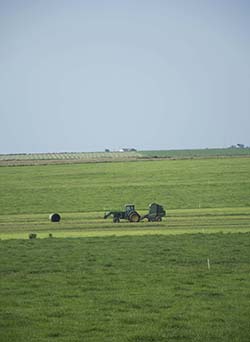 Whether it's made into dry hay or silage, alfalfa is a common ration ingredient that provides dairy cattle with a number of valuable nutrients. Unfortunately, there are parts of the alfalfa plant that are simply not digestible, and lignin is one of them.
Whether it's made into dry hay or silage, alfalfa is a common ration ingredient that provides dairy cattle with a number of valuable nutrients. Unfortunately, there are parts of the alfalfa plant that are simply not digestible, and lignin is one of them.Lignin fills the spaces in the cell wall between cellulose, hemicellulose and pectin molecules. Even though it is not digestible by cows, lignin is not all bad; in fact, a plant needs some of it. For starters, lignin provides strength to the plant. It also allows the plant's vascular system to transport water without leakage. Lignin sequesters atmospheric carbon into vegetation, and it is one of the most slowly decomposing components of dead vegetation, contributing a major fraction of soil organic matter.
However, as a plant becomes more mature, the amount of lignin in it goes up, and unfortunately, the digestibility of the plant goes down. One option to reduce the nondigestible components is to choose a reduced lignin alfalfa variety. David Combs with the University of Wisconsin-Madison discussed this new opportunity during his presentation at the 4-State Dairy Nutrition and Management Conference held in Dubuque, Iowa.
Reduced lignin alfalfa varieties can improve hay quality by slowing down lignin buildup in maturing alfalfa, potentially widening the harvest window. Alfalfa could also be harvested later, making full use of the growing season and leading to greater tonnage per cutting. Combs pointed out that a 15 to 18 percent reduction in lignin means we could harvest eight to 10 days later.
Reduced lignin alfalfa varieties are created either through breeding or genetic modification. Research trials have looked promising, Combs noted, but no peer reviewed research has been released yet.
According to Combs, very little reduced lignin alfalfa seed is available right now, but he believes it will be more widely distributed next year. When more options do become available on the market, Combs encourages producers to take a look at them. He does offer this caveat: "Use them if they yield as well (as other non-reduced lignin varieites). Don't just look at quality; look at yield," he said. "Yield is still the driver of economics."

The author is an associate editor and covers animal health, dairy housing and equipment, and nutrient management. She grew up on a dairy farm near Plymouth, Wis., and previously served as a University of Wisconsin agricultural extension agent. She received a master's degree from North Carolina State University and a bachelor's from University of Wisconsin-Madison.








